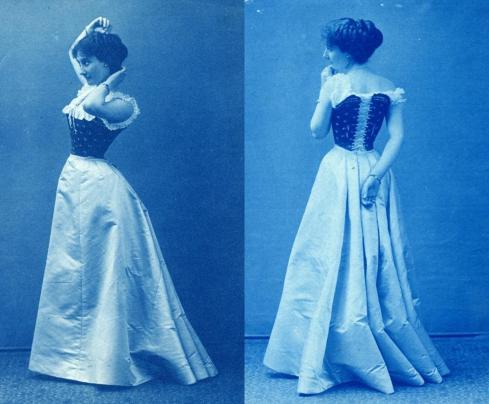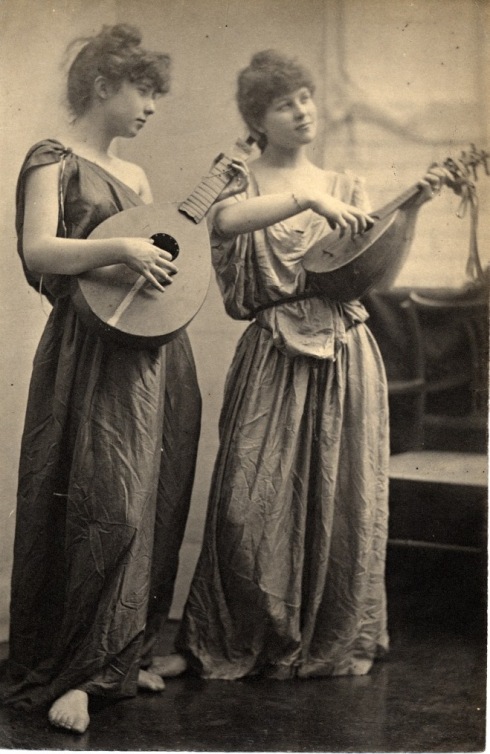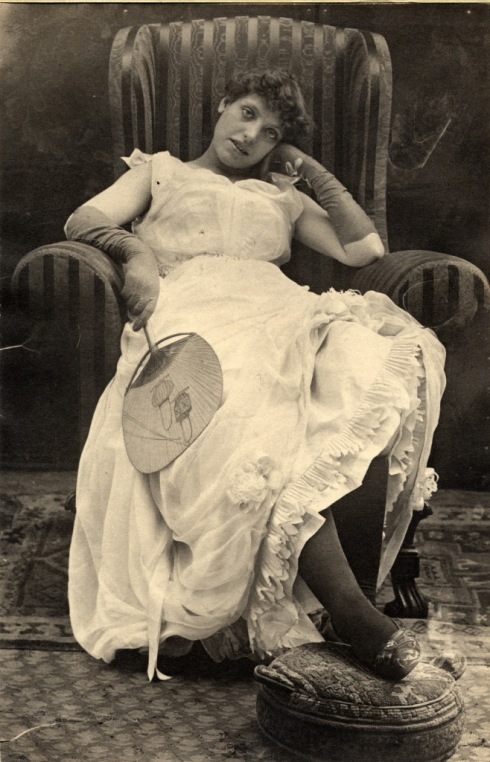Readers of my first Sambourne post will remember this lady:

Edward Linley Sambourne, illustrator and cartoonist, took the photo on September 28th 1896, probably at the Camera Club in Charing Cross Road, a studio and meeting place where amateur photographers could share models, equipment and expertise. Here is the same woman, I think, later or earlier on the same day standing on the same spot.

And that’s the problem with Sambourne in two images really. He had a passion for photography, a practical use for it in his professional career as an artist, and he liked taking photographs of women in various states of undress. You can’t insist that this is unequivocally an erotic image. She’s just standing there with a slightly challenging expression. But it has been argued that a significant number of the 30-50,000 photographs Sambourne took in his life do have some erotic content.
And then there’s us looking at the picture more than a hundred years later. Costume historians would no doubt find this pair of images highly instructive. Why did they wear so much clothing? Standing at a bus stop this morning I saw women on their way to work fully dressed and yet wearing less than the model in this picture. But still, she’s the one in her underwear. So is the woman below, taken a couple of years earlier in 1894:

Here Sambourne is probably looking at the way this petticoat or underskirt would support a dress and how it would affect the woman’s overall shape fully clothed. This sort of thing was of genuine interest to Sambourne as were some quite odd looking pictures like the one below.

This is definitely one of those poses for a cartoon which form a large proportion of Sambourne’s works. Quite what this pose is for is not immediately obvious although I’m sure Sambourne experts could tell us. It’s also interesting to note the makeshift background and props, the half-fallen back cloth and the table or boxes covered with dustsheets. The background was unimportant compared to the pose. This was definitely a reference photograph.

This one looks like it was taken in the yard behind Sambourne’s Stafford Terrace house. The model is perched precariously on what looks like a pile of old furniture. The unrolled scroll is some kind of prop, and the model is staring at a wooden pole for some unexplained reason. These odd photographs can sometimes be explained if you have the relevant drawing which was the end result. They do have an odd kind of charm in isolation though.
Here are two examples of the picture and the cartoon together:

The odd pose taken up by Sambourne’s indulgent wife Marion in the photograph is explained by the cartoon called Leap Year.

The photo from 1908 shows Sambourne acting as his own model.
Photography and art had been linked since the former came into general usage. Many serious painters were using photographs in addition to working with live models. Classical subjects for paintings were still popular and many photographers like Sambourne attempted to create images in the classical style with sometimes mixed results.

This one looks like the model has been draped in whatever suitable material came to hand. I can’t help thinking that the staff she is holding looks like a household appliance – something for opening high windows or snuffing out candles perhaps. The painter still had the advantage of only being limited by his or her ability and imagination. The photographer could produce a perfect image but had to work with the material to hand. This is a much better result:

We know the names of some of Sambourne’s models but I don’t know this lady posing an an artist.
The two musicians below may be Kate Manning and Louise Price. (Some of you may be able to correct me on that).

I’m not sure the instruments look ancient Greek. The artist again, now possibly carrying a curtain rod:

Just as Sambourne’s street photos reveal a casual attitude to dress I’m struck by the modern looking hair styles in some of these pictures. Whether the models wore their hair like this in the street is another question.
You can see part of a painting behind her which might mean that the picture was taken in the studio of Sambourne’s friend Edwin Austin Abbey in Bedford Gardens. Here you see two models getting ready for another picture.

These, I think are the Pettigrew sisters, Lily and Hetty, who posed for several well known painters including Millais and Alma Tadema. (This has now been confirmed by their descendant Neil Pettigrew – see his comment below)
Here is a more ambitious effort:

Miss Alice Smith, I believe swirling around the draperies for some effect Sambourne wanted to capture. Tiring work even if it might have been marginally easier working for a photographer than a painter. But there was still time to relax.

Hetty Pettigrew again, putting her feet up for a moment. Models have been putting up with the artistic whims of photographers and painters for a long time now.
Postscript
There was a flurry of interest in Sambourne last week resulting in a sudden increase in page views on the blog so this post is a reward for all the Sambourne fans as I’ve used most of the street images I scanned back in 2006. These images are a few of the thousands in the Sambourne collection. Leighton House are about to embark on a programme of digitisation which make more of the collection available to researchers. The transcribed diaries of Sambourne’s wife will also soon be available online.
“Public artist, private passions: the world of Edward Linley Sambourne”, a catalogue of the 2001-2002 Sambourne exhibition, (curated by Reena Suleman and Alison Smith, catalogue edited by Robin Smith) was very useful for background information on Sambourne. The photo/cartoon combinations are taken from the book. As is this image from 1888 which shows that Sambourne was just as happy to make himself look foolish for a picture.

The other Linley Sambourne posts are here (1st), here (Kensington), here (Holland), here (Paris)and here (at the beach).
 This hall is pleasantly cluttered with a seemingly random collection of art objects. It seems to be a common feature in the rooms of Luker’s friends, like at Lowther Lodge. (An interesting building in itself.)
This hall is pleasantly cluttered with a seemingly random collection of art objects. It seems to be a common feature in the rooms of Luker’s friends, like at Lowther Lodge. (An interesting building in itself.)





































































































